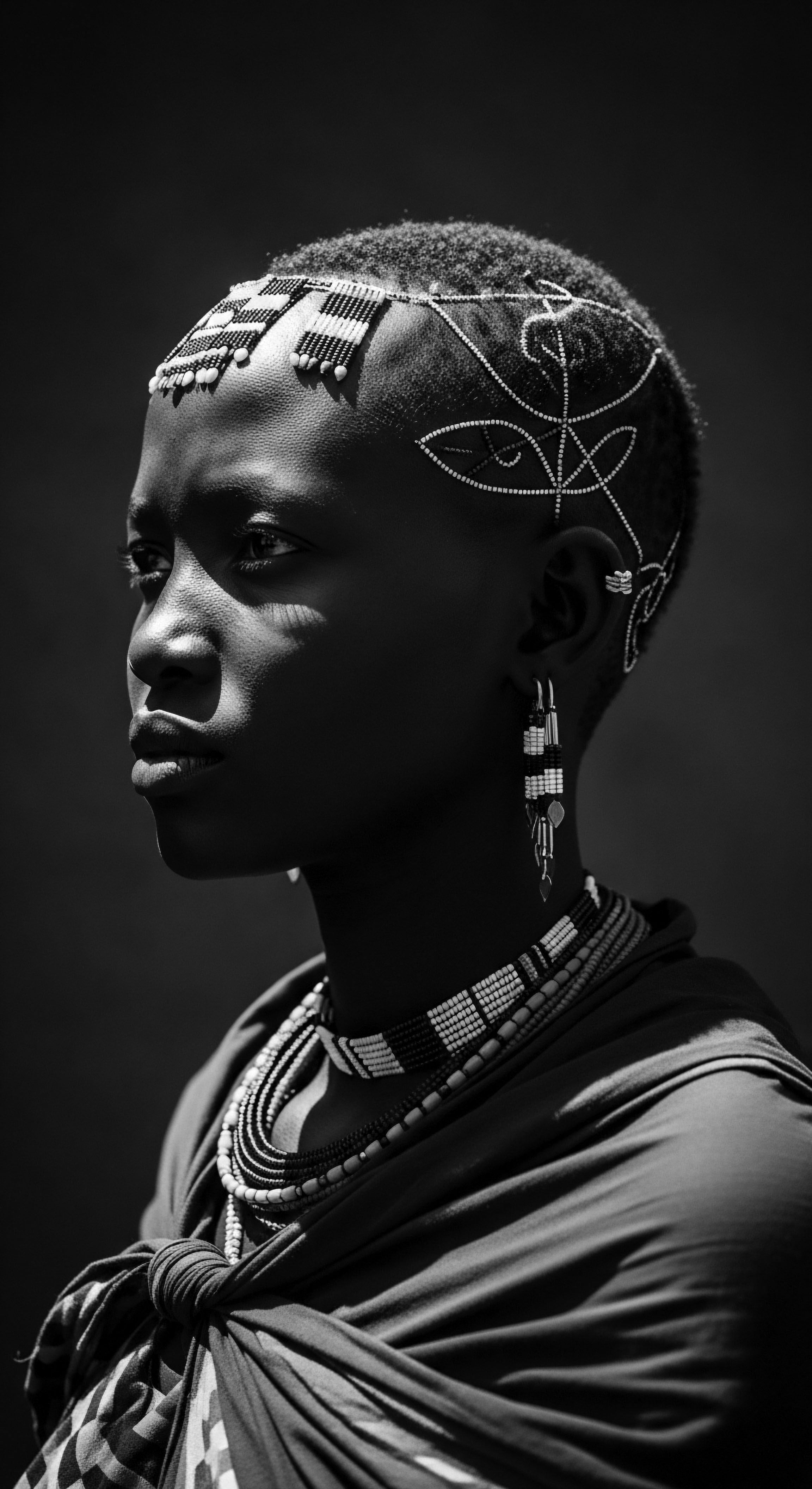
Fundamentals
The term Hair Rituals Ethiopia refers to the long-standing, deeply embedded customs and practices surrounding hair care, styling, and adornment within the diverse communities across Ethiopia. It is a comprehensive definition encompassing not just the aesthetic choices individuals make for their hair, but also the profound cultural meanings, social functions, and ancestral wisdom that underpin these traditions. The elucidation of these practices reveals a heritage where hair serves as a profound visual language, communicating identity, status, and connection to the land itself.
From ancient times, hair in Ethiopia has held a unique place, far surpassing mere physical appearance. The designation of specific styles and care regimens has consistently been a communal endeavor, reflecting societal values and collective histories. This shared understanding of hair’s purpose is a testament to its enduring significance. The historical context of Ethiopian hair rituals speaks to a continuity of practice, handed down through generations, making each strand a carrier of stories and inherited knowledge.

The Sacred Strands ❉ Early Meanings
In the elemental biology of textured hair, particularly those with tightly coiled patterns, the need for intentional care becomes evident. Ethiopian ancestors understood this intrinsic need, developing methods and ingredients that honored the hair’s natural inclinations while promoting its vitality. This primary understanding, often termed Echoes from the Source, points to an ancient recognition of hair as a living, breathing entity deserving of thoughtful attention.
The early meanings ascribed to hair in Ethiopia were often tied to spiritual beliefs and the rhythms of life. Hair was perceived as a conduit between the individual and the cosmos, a visible representation of one’s spirit and lineage. This perspective shaped the very foundation of hair care, transforming it from a routine task into a reverent act.

Community and Connection in Early Hair Practices
In early Ethiopian societies, hair practices were rarely solitary. They unfolded within the embrace of family and community, fostering bonds and transmitting intergenerational knowledge. The act of braiding or oiling another’s hair became a tender thread, a physical manifestation of care, storytelling, and shared heritage. This communal aspect ensured the perpetuation of specific styles and the associated meanings, grounding them firmly within the collective memory.
Ethiopian hair rituals stand as a living archive of heritage, where each braid and treatment speaks volumes about identity, community, and ancestral wisdom.
The use of natural ingredients, often sourced directly from the earth, forms a central pillar of these foundational hair rituals. These ingredients, imbued with the earth’s energy, were understood not merely for their cosmetic effects but for their holistic contributions to well-being.
- Kibeh ❉ A traditional clarified butter, extensively employed for deep conditioning and promoting hair growth. This substance is revered for its ability to moisturize and strengthen hair, reducing breakage and enhancing length retention.
- Local Herbs and Plants ❉ Various indigenous plants, documented for their use in hair and skin care among communities like the Afar people, serving as treatments and cleansing agents.
- Clay and Ochre ❉ Used by certain groups, such as the Hamar, to create distinctive hair sculptures and provide protection.

Intermediate
Moving beyond initial interpretations, the intermediate meaning of Hair Rituals Ethiopia expands to encompass the dynamic interplay between cultural identity, societal roles, and the sophisticated artistry expressed through hair. This expanded understanding reveals how specific styles and care regimens serve as powerful non-verbal communicators, transmitting intricate details about an individual’s background and station within their community. The designation of these practices as intermediate reflects a deeper recognition of their complex symbolism and the historical evolution of their forms.
The cultural significance of Ethiopian hairstyles is multi-layered, reflecting centuries of tradition. Styles are not arbitrary choices; they articulate lineage, marital status, age, social standing, and even geographic origin. This depth of communication transforms hair into a tangible representation of belonging and heritage. The very act of creating and maintaining these styles often unfolds within communal settings, preserving these practices through active participation and storytelling.

The Tender Thread ❉ Living Traditions of Care
The practices that constitute the Tender Thread of Ethiopian hair rituals extend beyond mere aesthetics, reaching into the realm of holistic wellness and community engagement. Traditional hair care in Ethiopia is often a time-consuming, communal activity, reinforcing familial bonds and transmitting cultural narratives. This collective aspect of hair maintenance is remembered throughout Africa and its diaspora, sitting between loved ones as braids are painstakingly crafted, stories exchanged, and wisdom passed down.

Regional Variations and Identity Markers
Ethiopia’s vast cultural landscape yields a rich diversity of hair practices. Each ethnic group possesses a unique repertoire of styles and traditions, serving as distinct markers of identity.
For the Amhara people, hair styling is a vital expression of heritage. Three primary styles hold sway ❉ Shruba (braids), Gofere (Afro), and various forms of dreadlocks. Shruba encompasses different braiding patterns that often indicate age groups and social statuses.
A specific braiding style, Gamme’Quncho, is traditionally worn by young girls and boys who have not yet reached marriageable age, featuring braids cascading to the side with a shaved middle section. As a girl nears marriage, the shaved part is allowed to grow, integrating into the back braids, marking a transition in her life.
Among the Tigrayan people, hair styles also convey information about age and marital status. Young girls might shave parts of their heads, allowing the hair to grow in fully as they mature and marry, with intricate braiding styles such as Gilbich (very fine braids) and Albaso (coarser braids) showcasing remarkable artistic skill. The cultural importance of these designs is deeply woven into the fabric of Tigrayan identity, reflecting a history spanning ages.
The Oromo people, particularly Oromo women, use traditional hairstyles as profound emblems of beauty, respect, and social standing. The Goodaya hairstyle, for instance, holds significant cultural and symbolic meaning within Oromo society. These styles are not simply ornamental; they represent emancipation and connection to their cultural heritage.
Ethiopian hair practices are an intricate lexicon, where each coil and plait conveys an individual’s story, communal ties, and the deep roots of their lineage.
The Hamar people of the Omo Valley offer another compelling example of hair as a life chronicle. Their unique dreadlocks, often buttered and adorned with red ochre, change significantly through a man’s life. Before participating in the essential Bull Jumping Ceremony, young men may keep their hair in braids. Upon preparing for the ceremony, their hair is shaved from the hairline to the crown.
A successful completion of the ceremony, which qualifies young men to marry, leads to their heads being shaved bald. Only after marriage do they regrow their hair to its normal Hamar style, often maintained with butter and mud. This practice offers a potent demonstration of how hair transforms from a mere physical attribute into a ceremonial canvas, marking pivotal life transitions and earned societal status within a specific cultural framework.
| Ethnic Group Amhara |
| Traditional Styles/Practices Shruba (braids), Gofere (Afro), Gamme'Quncho |
| Cultural Significance Age, social status, transition to marriage, symbol of resistance. |
| Ethnic Group Tigrayan |
| Traditional Styles/Practices Gilbich (fine braids), Albaso (coarse braids), shaved patterns |
| Cultural Significance Age, marital status, artistic skill, regional identity. |
| Ethnic Group Oromo |
| Traditional Styles/Practices Goodaya, various braids and adornments |
| Cultural Significance Beauty, respect, emancipation, connection to cultural identity. |
| Ethnic Group Hamar |
| Traditional Styles/Practices Butter-dreadlocks, ceremonial shaving, ochre application |
| Cultural Significance Life transitions (e.g. bull jumping), marital status, community standing. |
| Ethnic Group Afar |
| Traditional Styles/Practices Asdagos and Daytas (for men), plant-based treatments |
| Cultural Significance Protection, cultural pride, personal hygiene. |
| Ethnic Group These diverse traditions underscore the profound role hair plays in articulating shared heritage and individual narratives across Ethiopia. |

The Science in Ancestral Wisdom
Traditional Ethiopian hair care methods, honed over centuries, often align remarkably with contemporary scientific understanding of hair health. The use of Kibeh (clarified butter), for example, is not merely a cultural practice; it is a deeply nourishing treatment. Raw butter is applied to hair to reduce breakage, improve length retention, and stimulate growth.
From a scientific perspective, butter provides lipids and fatty acids that can deeply moisturize the hair shaft, contributing to elasticity and reducing brittleness, thereby minimizing breakage. Its occlusive properties can also help seal in moisture, making it an effective pre-shampoo treatment or leave-in conditioner.
Similarly, the traditional reliance on indigenous plants and natural oils for hair care, as observed among the Afar people, highlights an intuitive ethnobotanical knowledge. A study identified 17 plant species used for hair and skin care by the Afar, with leaves being the most frequently utilized part and topical application as the primary method. This practice speaks to a deep appreciation for the botanical world’s capacity to provide nourishment and protection for textured hair. This deep respect for ancestral knowledge and its practical applications grounds Roothea’s perspective, bridging historical practice with current understanding.

Academic
The academic interpretation of Hair Rituals Ethiopia delves into the intricate socio-cultural, historical, and biological dimensions that underpin these practices, positioning them as a critical lens through which to comprehend Ethiopian identity, resilience, and the broader Black/mixed hair experience. This scholarly definition examines the comprehensive systems of meaning and designation attached to hair, moving beyond descriptive accounts to analyze their profound implications within a complex tapestry of human behavior, collective memory, and ancestral continuity. It offers an interpretation grounded in rigorous research, dissecting the historical currents and psychological impacts of hair practices.

Echoes from the Source ❉ Hair as Historical Text
Hair in Ethiopia has served as a tangible, living historical text, documenting societal shifts, resistance movements, and the enduring spirit of its peoples. This conceptualization views hair not merely as a biological outgrowth, but as a medium for communicating complex societal narratives, particularly those of defiance and self-determination. The deep lineage of African hair styling, predating colonial encounters, conveyed detailed social commentary, tribal affiliations, and even, in some contexts, secret maps to freedom for enslaved peoples (Dabiri, Twisted ❉ The Tangled History of Black Hair Culture, 2020). This historical depth provides a crucial framework for understanding the particular significance of Ethiopian hair rituals.

The Unbound Helix ❉ Hair as a Symbol of Resistance
The notion of hair as a symbol of identity and resistance finds a particularly compelling historical instance in Ethiopia, a nation that uniquely resisted colonization by European powers. Unlike many other African nations where colonial regimes imposed Eurocentric beauty standards that necessitated the “taming” or straightening of Black hair, Ethiopian hair traditions largely maintained their authenticity and inherent cultural value. This sustained self-definition through hair becomes a powerful case study in cultural sovereignty.
A striking example is the Gofere (Afro) hairstyle, especially among Amhara Women during the Italian occupation of Ethiopia from 1935 to 1941 . The Gofere became more than a mere hairstyle; it embodied opposition and fortitude. Women patriots, known as arbegnoch, who fought alongside their male counterparts for Ethiopia’s liberation, prominently wore the Gofere. This hairstyle, therefore, transformed into a visible testament to their courage and unwavering commitment to freedom.
This specific historical example powerfully illuminates the Hair Rituals Ethiopia’s connection to Black hair experiences, showcasing how hair, when rooted in ancestral practices, can become a profound symbol of collective identity and active resistance against external impositions. This resistance through adornment stands as a powerful counter-narrative to the dominant historical experiences of hair policing in the diaspora, where textured hair was often devalued and stereotyped.
The refusal to abandon their distinct styles, even under the duress of invasion, speaks to a collective understanding of hair as an integral component of national and ethnic identity. The Amhara Gofere, in this context, serves as a powerful illustration of the agency inherent in traditional hair practices, where aesthetic choice becomes a political statement, a declaration of selfhood that refuses to be suppressed. This long-term consequence of historical self-determination manifests in the enduring pride associated with these traditional styles, even as they evolve in contemporary fashion.
The Gofere hairstyle, particularly during the Italian occupation, transformed into a powerful emblem of Amhara women’s unyielding resistance and the broader Ethiopian commitment to self-determination.

Interconnected Incidences ❉ Identity, Social Stratification, and Cultural Preservation
The analysis of Ethiopian hair rituals cannot be separated from the broader academic discussions on identity, social stratification, and cultural preservation within African societies. Historically, hairstyles conveyed messages about ethnicity, marital status, age, religion, and social standing. The precision and complexity of these designs reflected an organized social order where hair was a primary visual cue.
The continued practice of these rituals in modern Ethiopia, despite globalizing influences, represents a conscious act of cultural preservation. As model and collective founder Kiya Tadele explains, losing a hairstyle can mean losing a visual language, urging people to be proud of their “strong African hair” and aiming to bring these centuries-old styles back into contemporary expression. This continuous thread connecting the past to the present, resisting the homogenizing forces of external beauty standards, underscores the deep cultural work embedded in Hair Rituals Ethiopia. The dynamic intersection of historical continuity and contemporary adaptation reveals a vibrant, living heritage.
| Traditional Ingredient/Practice Kibeh (Clarified Butter) |
| Traditional Use/Significance Moisturizing, reducing breakage, promoting hair growth, traditional rites. |
| Modern Scientific Relevance/Benefit Rich in fatty acids and lipids, provides deep moisture, enhances hair elasticity, reduces dryness and dandruff. |
| Traditional Ingredient/Practice Ziziphus spina-christi (Korkor) |
| Traditional Use/Significance Hair and skin cleansing, treatments (Afar people). |
| Modern Scientific Relevance/Benefit Contains saponins, acting as natural cleansers, and emollients for conditioning. |
| Traditional Ingredient/Practice Sesamum orientale (Sesame) |
| Traditional Use/Significance Hair treatments, leave-in conditioner (Afar people). |
| Modern Scientific Relevance/Benefit Sesame oil is rich in vitamins (E, B complex) and minerals, known for nourishing scalp and strands, promoting growth. |
| Traditional Ingredient/Practice Honey |
| Traditional Use/Significance Moisturizing, symbolic of sweetness and abundance in beauty routines. |
| Modern Scientific Relevance/Benefit A natural humectant, drawing moisture from the air into the hair, providing conditioning and a healthy sheen. |
| Traditional Ingredient/Practice Red Ochre |
| Traditional Use/Significance Pigmentation, sun protection, cultural adornment (Hamar, Himba). |
| Modern Scientific Relevance/Benefit Offers UV protection, can act as a natural dye, and contributes to the physical stability of styles. |
| Traditional Ingredient/Practice The enduring efficacy of these ancestral ingredients underscores the profound indigenous knowledge systems within Ethiopian hair rituals. |
The meaning of Hair Rituals Ethiopia, at an academic level, is a nuanced exploration of human agency, cultural embeddedness, and the complex interplay between tangible practices and intangible heritage. It represents a continuous dialogue between the past and the present, where ancient wisdom finds contemporary validation, and each hair strand serves as a testament to the enduring power of cultural identity. The explication of these dynamics provides a comprehensive understanding of hair’s role in constructing and affirming selfhood within a distinct African context.

Reflection on the Heritage of Hair Rituals Ethiopia
As we consider the threads woven through the narrative of Hair Rituals Ethiopia, a profound sense of continuity emerges, one that reaches far back into the wellspring of ancestral practices and extends into the vibrant expressions of today. The enduring significance of these traditions for textured hair and its communities serves as a potent reminder that hair is rarely merely ornamental. It is a living, breathing archive, a testament to the resilience, creativity, and deep cultural memory of a people.
The meticulous attention to hair, passed from hand to hand across generations, mirrors the very act of preserving history. Each braid, each application of nourishing butter, each ceremonial style becomes a story told without words, speaking of lineage, identity, and an unbroken connection to the source of one’s being. The Ethiopian experience, particularly its sustained autonomy from colonial subjugation, allowed these hair traditions to flourish and evolve on their own terms, giving us powerful examples of hair as an emblem of freedom and self-possession. This unique historical trajectory enriches the global narrative of Black and mixed-race hair, offering profound insights into practices of self-definition and cultural fortitude.
Roothea’s ethos finds deep resonance in this heritage. The very act of caring for one’s textured hair, informed by the wisdom of Ethiopian rituals, transforms into a meaningful gesture of respect for ancestry and an affirmation of identity. It is an invitation to engage with the physical biology of our hair while simultaneously honoring the spiritual and cultural dimensions that have shaped its journey through time.
The lessons from Ethiopia remind us that true hair wellness extends beyond product application; it encompasses a soulful acknowledgment of where we come from, manifesting as a celebration of our heritage in every strand. This holistic approach empowers individuals to find their own rhythm of care, one that echoes the profound wisdom of their ancestors and builds a bridge to a self-defined future.

References
- Byrd, Ayana D. and Tharps, Lori L. Hair Story ❉ Untangling the Roots of Black Hair in America. St. Martin’s Press, 2002.
- Cobb, Jasmine Nichole. New Growth ❉ The Art and Texture of Black Hair. Duke University Press, 2023.
- Dabiri, Emma. Twisted ❉ The Tangled History of Black Hair Culture. Harper Perennial, 2020.
- Russell, Kathy, Wilson, Midge, and Hall, Ronald. The Color Complex ❉ The Politics of Skin Color in a New Millennium. Anchor Books, 2002.
- Sherrow, Victoria. Encyclopedia of Hair ❉ A Cultural History. Greenwood Publishing Group, 2006.
- Sieber, Roy and Herreman, Frank. Hair in African Art and Culture. The Museum for African Art, 2000.
- Wondimu, A. Zeynu, A. Eyado, A. & Mekonnen, Y. (2025). Plants used for hair and skin health care by local communities of Afar, Northeastern Ethiopia. Journal of Traditional and Complementary Medicine, 30.
